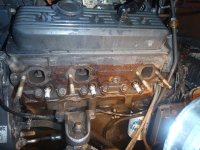Just trying to connect some of the dots . . .
"Manifolds were full of -50 F non-toxic antifreeze" . . . OK from winterization?
"Fresh Rebuild" . . . OK, what cam shaft may have been installed? Marine engines with wet exhaust need really mild cam shafts. In a quick search I was not sure about finding your engine rebuild thread.
Yes on the winterization. Raw water + NJ means I have to.
On the rebuild, I don't have the folder near me but it was a sierra PN that crossed to a mercruiser part number for that engine year range. I didn't have a serial number for the engine as it was rebuilt once before so we used the drive serial number to get a date range. My rebuild thread is the popped through the intake thread which was basically me pulling the engine and having the machine shop do it because I didn't have the time. But they did run through everything. This is arguably one of the tamest sounding 4.3Ls I've ever been around. I'm used to them having some chop or rumble being a six cylinder and this thing just idles like a civic... I'm also used to the 3.0l which was quite choppy by comparison.
I'll also add that there appears to only be 2 possible part numbers for the 4.3l. I have the one that crosses to the later number, but is still used in the 4v quicksilver rebuilds if I'm recalling. But that still wouldn't explain why it is only effecting one bank even if it is reversion...
What I'd want to do, even tho it's a pain, is remove the manifolds & elbows & set them up level, so you can see into the exhaust ports, and fill with water. Let it sit and heat the side of manifold with a heat gun to about 140* or so. See what happens....
Here's a pic of my 4.3 from a long time ago (2011 I think) when I still had the OMC one piece V6 manifolds. I had to change them every 5-6 seasons. Note that there is no rust whatsoever in the exhaust ports and this is a 100% salt water boat, moored in salt water all season. The rust on the cyl head is just from moisture from condensation held against the head by the larger style exhaust gasket.
View attachment 393073
The flow test was done on my work bench. I do have a heat gun and could try that and see what happens... or I could also run heated water through them as I have a 160 gallons of heated water just inside the door....
I'm also, with a clearer head, going to go back and retest the manifold in question. I do want to get back on the engine but it hasn't stopped raining since this time yesterday and I'd prefer to keep the inside of the boat as dry as possible for now...
the plan is an extension on the boot off the elbow with a cap to seal the water side. I have the exhaust portion of the manifold/elbow assembly sealed with a plug at the moment that will allow me to only pressurize the water side. I'll take it up to 20 static which should be more than that system would ever see and probe around. I'm also taking my borescope and inspecting the joint itself from inside the port. I'm going to get to the bottom of it. If that don't come back conclusive I'm going to turn back to the block but unless the rain let's up I don't think it's happening.




















